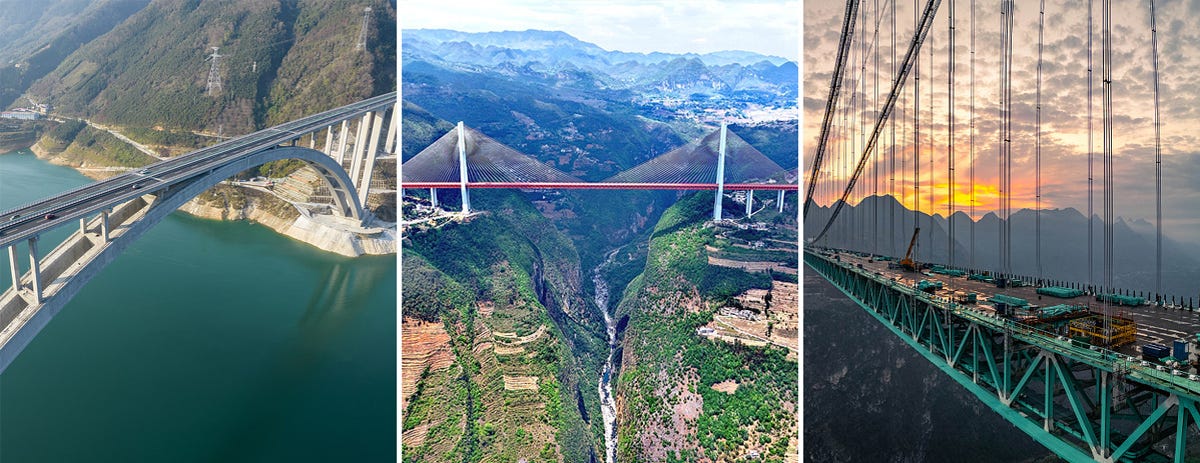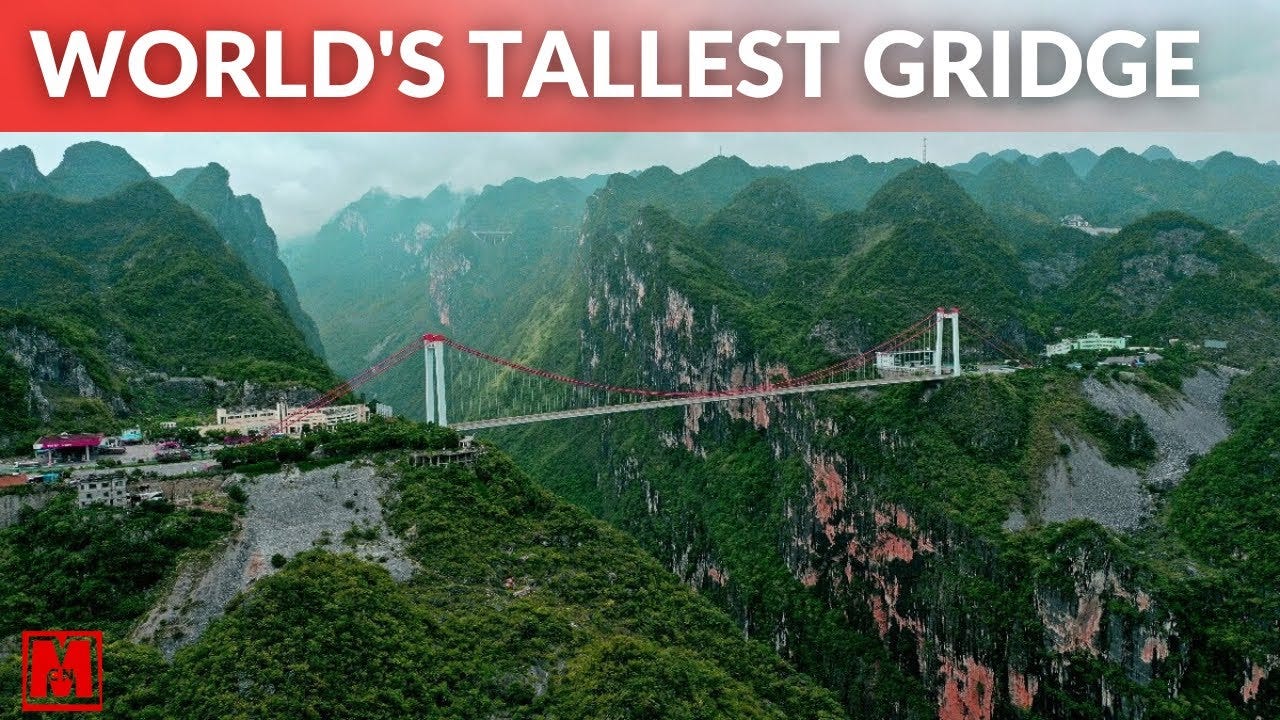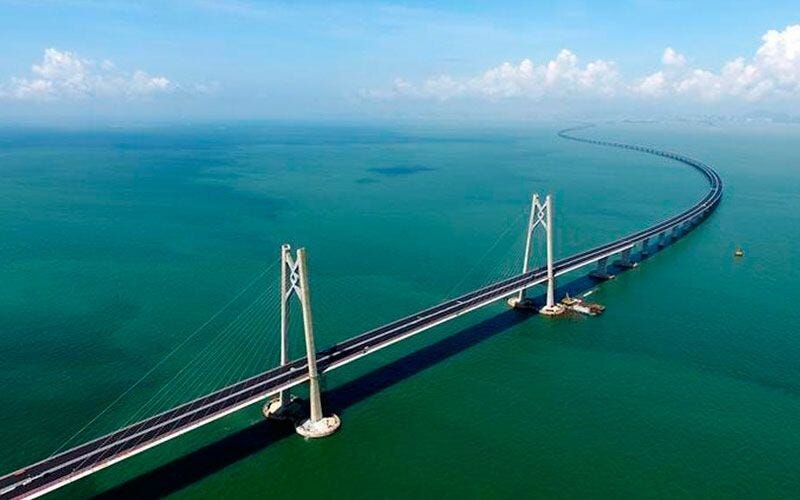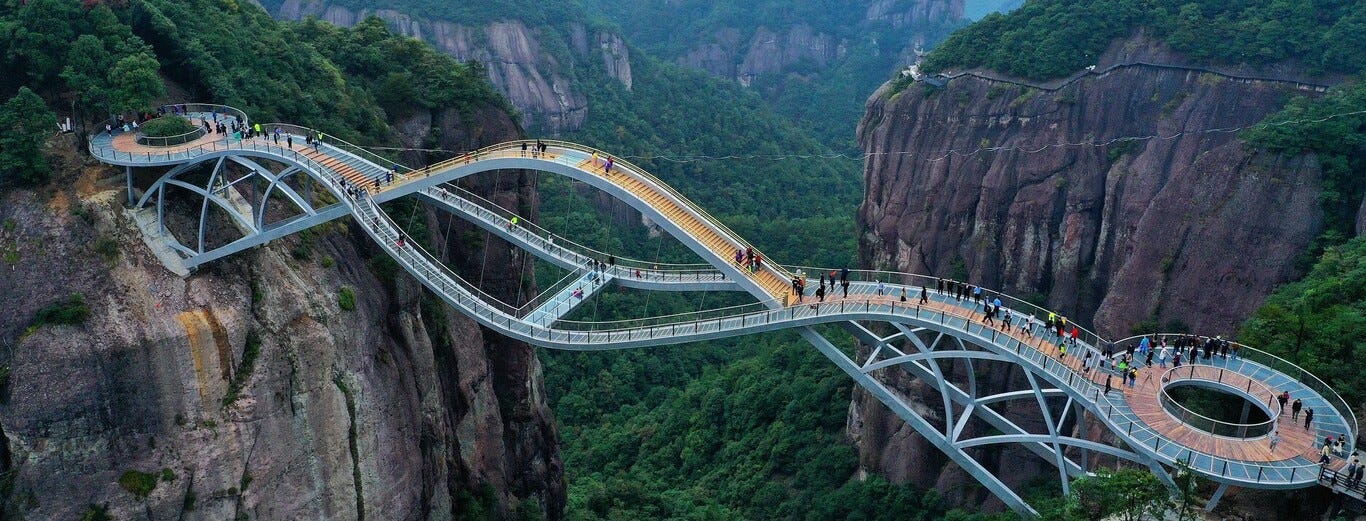Hechi, Guangxi, Tian'e Longtan Bridge; Liupanshui, Guizhou, Beipanjiang Bridge; Huajiang Bridge under construction
Finished product. Funny typo from original. It cost ¥1.023 billion and took five years to build, about $142 Million at today’s exchange rate.
Fourteen months ago, the Francis Scott Key Bridge collapsed after a container ship struck one of its piers in a maritime accident having very few precedents. The process involved in its replacement is worth reading as it reveals numerous bureaucratic snags that must be overcome. The cost comparison from initial to replacement construction tells its own story—”The original bridge cost $141 million [in 1977] to build, about $743 million in 2024 dollars” while it’s estimated cost when finished in 2028 is $1.7 billion to $1.9 billion: over ten times the initial cost. I provide this information as a way to compare what the article describes. Aside from the header image, the article has many more that are worth viewing even without translation.
According to a report by Hong Kong's South China Morning Post on May 26, a recent study published in the domestic journal Transportation Science and Engineering said that by 2030, "China's bridge manufacturing" will have all the following achievements: the world's longest suspension bridge, the world's tallest bridge, and all cable-stayed bridges that have set various records. In response, the report lamented that China has "redefined the limits of civil engineering".
"China's Bridges: Build Smarter, Build Higher, Where No One Else Dare Build," the report said, adding that it took only a generation for China to go from relying on foreign bridge-building technology to becoming "the undisputed designer of the world's boldest bridges." "From mist-shrouded canyons to typhoon-ravaged straits to vast metropolitan areas, Chinese engineers are building structures that push the limits of geography and set new world records."
According to the South China Morning Post, the study points to sophisticated survey methods, advanced modelling and innovative engineering techniques, including breakthroughs in materials science, that have enabled China to continue to build large bridges. At the same time, the rapid development of artificial intelligence (AI) technology and the application of intelligent and automated construction equipment will also make bridge construction safer and more efficient.
The following are some of the domestic bridge engineering projects that have attracted the attention of the report. Some of them have been completed and set world records; Some are nearing completion and are expected to set records when they are completed:
Changtai Yangtze River Bridge (Jiangsu)
The Changtai Yangtze River Bridge, which connects Changzhou and Taizhou, will become the world's largest cable-stayed bridge after it opens to traffic this year. It is reported that the current holder of this record is the Russky Island Bridge, which was completed in 2012, with a main span (that is, the span between the main supporting structures) of 1,104 meters, and the main span of the Changtai Yangtze River Bridge reached 1,208 meters.
According to China Railway Corporation Limited (CREC), the Changtai Yangtze River Bridge is 10.03 kilometers long, and the road-rail section is 5.3 kilometers long, making it the world's first cross-river passage integrating expressways, intercity railways and ordinary highways. The bridge was designed by the China Railway Bridge Bureau, and the construction started in October 2019.
According to the information provided by the China Railway Bridge Bureau, as of January this year, the ancillary project of the Changtai Yangtze River Bridge has been basically completed, and the highway is expected to be opened to traffic in October.
The South China Morning Post pointed out that among the top 10 cable-stayed bridges in the world that have been put into operation, Russia's Russky Island Bridge tops the list, while two bridges from France and Japan are also on the list, and China currently occupies the remaining seven places. But by 2026, there will be nine Chinese bridges in the top 10.
Zhangjinggao Yangtze River Bridge (Jiangsu)
On the 26th of this month, the middle beam of the south main tower of the south channel bridge of the Zhangjinggao Yangtze River Bridge, which connects Zhangjiagang, Jingjiang and Rugao, was successfully completed, which is one step closer to the successful capping of the main tower. It is reported that the Zhangjinggao Yangtze River Bridge is planned to be completed in 2028, when its main span will reach 2,300 meters, which will become the world's largest suspension bridge.
Unlike cable-stayed bridges, which are shaped like giant fans and "hang" the main girders directly on the pylons through diagonal cables, the main girders of the suspension bridge conduct the force to the cables through vertical booms, and the cables are suspended and anchored on both sides of the bridge through the pylons, hanging down from top to bottom, and the shape is generally close to a parabola. [See Diagram at article.]
In addition to the world's largest span suspension bridge, the Zhangjinggao Yangtze River Bridge is expected to set five "world's best" records after completion, including the world's tallest suspension bridge pylon, which is 350 meters high, equivalent to a 125-story building, the world's longest high-strength main cable, the world's largest ground wall anchor foundation, the world's longest continuous length steel box girder, and the world's largest displacement telescopic device.
At the same time, the bridge will also have 6 "world's first" designs, including the self-balancing structure system of the main cable of the super-large span suspension bridge, and the integrated intelligent anti-corrosion system of the whole bridge. Especially in terms of structure, the main tower adopts the world's first steel box-concrete-filled steel tube restraint combination system, which can increase the bearing capacity of the tower column by 30% while reducing the weight of the tower body by 50%, effectively solving the world-class problem of ultra-high and overweight of the two-kilometer-level suspension bridge tower.
According to the South China Morning Post, almost all of the suspension bridges currently under construction in the world are located in China. Among the suspension bridges that have been opened to traffic, the world record for the longest span is held by Turkey's 1915 Canakkale Bridge, which has a main span of 2,023 meters and was completed and opened to traffic in 2022; This is followed by the Akashi Kaikyo Bridge in Japan and the Yangsigang Yangtze River Bridge in Wuhan, China.
Dankunt Bridge (Jiangsu)
It’s very hard to imagine the fantastical length of this bridge system with this image giving an idea as it disappears in the distance. 164 Km or 102 miles.
The Dankunte Bridge, also known as the Danyang-Kunshan Bridge, is a viaduct composed of many short spans in the Jiangsu section of the Beijing-Shanghai high-speed railway, with a total length of 164.8 kilometers, and is also the world's longest bridge recorded in the Guinness Book of World Records.
Since its completion in 2010 and commissioning in 2011, the Danquint Bridge has held this record. But the South China Morning Post said that record could be broken by India's Mumbai-Ahmedabad Bullet Train Corridor in the future.
It is reported that the Mumbai-Ahmedabad high-speed rail corridor is scheduled to be completed in 2028 and will have a total length of 508 kilometers when completed, most of which will consist of viaducts.
Xihuomen Road and Railway Bridge (Zhejiang)
The Xihuomen Highway and Railway Bridge is a common cross-sea bridge between the Yongzhou Railway and the Ningbo-Zhou Expressway double-track across the Xihuomen Waterway, connecting Zhoushan Jintang Island and Zhangzi Island, and is a control project of the Ningbo-Zhou Railway.
According to CCTV News, the Xihuomen Highway and Railway Bridge has a total length of 3,118 meters, the main span adopts a 1,488-meter cable-stayed suspension cooperation system, and the bridge deck is 68 meters wide. In addition, the pile foundation of the bridge is made of bored piles with a diameter of 6.3 meters, and the bedrock is 60 meters deep, which is also the largest bridge construction in the world.
Tian'e Longtan Bridge (Guangxi)
Opened to traffic in February last year, the Tian'e Longtan Bridge in Tian'e County, Guangxi Province, is now the world's largest span arch bridge. It is located 6 kilometers upstream of the Longtan Power Station Dam in Tian'e County, Hechi City, Guangxi, across the Hongshui River, with a total length of 2488.55 meters and a calculated span of 600 meters for the main bridge.
According to a report by China Communications News in February last year, the calculation span of the 600-meter main bridge of the Tian'e Longtan Bridge has increased the world record of the span of similar arch bridges (the Beipanjiang Bridge built in 2016), far exceeding the average annual development rate of 1.5 meters for the span of the same type of arch bridge.
The report also introduced that many innovative construction techniques were adopted in the construction of Tian'e Longtan Bridge, and successively overcame the construction of deep foundation pits, high piers, arch large-volume concrete and arch rib processing and manufacturing, arch columns, T beam hoisting and other construction problems, which is expected to provide an important reference for the construction of concrete arch bridges in mountainous areas in the future.
Huajiang Gorge Bridge (Guizhou).
Guizhou Huajiang Gorge Bridge, named after the Huajiang Grand Canyon known as the "crack in the earth", has a total length of 2,890 meters, a main span of 1,420 meters, and a height of 625 meters from the water surface, which is equivalent to the Shanghai Tower, equivalent to more than 200 floors.
According to China Railway Second Bureau Group Company, the construction of the Huajiang Gorge Bridge will start in 2022, be completed in January this year, and is expected to open to traffic in June. After completion, it will surpass the Beipanjiang Bridge and become the world's tallest bridge, and set a record for the world's largest suspension bridge span in mountainous areas, so it is also described as "the first in both horizontal and vertical".
It is worth mentioning that the total weight of the steel truss girders of the bridge is about 22,000 tons, which is equivalent to three Eiffel Towers, but the construction team completed the installation of the steel truss girders in only two months.
Beipanjiang Bridge (Guizhou, Yunnan)
About 200 kilometers away from the Huajiang Gorge Bridge, the Beipanjiang Bridge holds the current Guinness Book of World Records for the world's tallest bridge, with a vertical height of 565.4 meters from the bridge deck to the river surface.
Beipanjiang Bridge, also known as "the first bridge of Beipanjiang River", jointly built by Yunnan and Guizhou provinces, is located on the Nizhu River at the junction of the two provinces, with a total length of 1341 meters, connected with Duge Town, Shuicheng District in the east, and Puli Township, Xuanwei City, Qujing City in the west, which is a part of Hangrui Expressway. In 2016, the Beipanjiang Bridge was officially opened to traffic.
According to public data, nearly half of the world's top 100 bridges are in Guizhou, of which 4 of the top 10 bridges are in Guizhou, and 15 bridges have won a total of 25 international and domestic awards, of which 4 bridges have won the Gustav Lindthal Prize of the International Bridge Conference (IBC), which is known as the Nobel Prize in the bridge industry, accounting for four-ninths of the country.
Shiziyang Bridge (Guangdong)
With a main span of 2,180 meters, the Shiziyang Bridge, which connects Guangzhou and Dongguan, is expected to become the world's first double-decker suspension bridge of more than 2,000 meters, as well as the world's second-span suspension bridge, after the Zhangjinggao Yangtze River Bridge, which is also expected to be completed in 2028.
The height of the main tower of the Shiziyang Bridge is 342 meters, which is equivalent to the height of a 110-story building, which also means that it will be the world's tallest double-decker suspension bridge main tower when completed. According to the news released by the Guangdong Provincial Communications Group, as of the early morning of April 2, the T20 section of the tower of the Shiziyang Bridge has been poured, and the construction height has exceeded 100 meters.
Pingnan Third Bridge (Guangxi)
Until the Tian'e Longtan Bridge opens to traffic in 2024, the Pingnan Third Bridge in Guangxi, which was completed in 2020, has been ranking first among the world's largest span arch bridges. The total length of the bridge is 1035 meters, the main bridge span is 575 meters, the central bearing concrete tube arch bridge, and the approach bridge is made of prestressed concrete continuous box girder.
However, the South China Morning Post said that the position of the "world's second arch" of the Pingnan Third Bridge may also soon be "handed over" - the 580-meter main span of the Fenglai Bridge in Chongqing, which is under construction, is expected to open to traffic later this year.
Shanghai-Sutong Yangtze River Railway Bridge (Jiangsu)
The Shanghai-Sutong Yangtze River Highway and Railway Bridge was officially opened in 2020, with a main span of 1,092 meters, a total length of 11.07 kilometers, and a main tower of 330 meters high.
As a control project across the Yangtze River of the Shanghai-Sutong Railway Section of China's coastal railway corridor, the Shanghai-Sutong Yangtze River Highway and Railway Bridge integrates the three functions of national railway, intercity railway and expressway, and the upper layer is a two-way six-lane expressway with a design speed of 100 kilometers per hour; The lower level is a four-line railway, of which the Shanghai-Sutong railway has a design speed of 200 kilometers per hour, and the Tongsu-Jiayong intercity railway has a design speed of 250 kilometers per hour.
Guanyin Temple Yangtze River Bridge (Hubei)
With a total length of 1,860 meters and a main span of 1,160 meters, the Yangtze River Bridge is expected to open in 2026, when it will replace the Shanghai-Sutong Yangtze River Highway and Railway Bridge as the world's second-span cable-stayed bridge.
The original world's second-span cable-stayed bridge, also located in Hubei, the Ma'anshan Yangtze River Road and Railway Bridge (main span 1,120 meters), will also be moved back due to the completion of the Guanyin Temple Yangtze River Bridge.
However, when completed, both cable-stayed bridges will surpass the current record holder for the world's longest cable-stayed bridge, the Russky Island Bridge in Vladivostok, Russia.
Hong Kong-Zhuhai-Macao Bridge (Guangdong-Hong Kong-Macao)
The 55-kilometre-long bridge that spans the Pearl River estuary and connects Hong Kong, Zhuhai and Macau is the longest sea-crossing bridge in the world, consisting of three cable-stayed bridges, an undersea tunnel and four artificial islands.
Construction of the Hong Kong-Zhuhai-Macao Bridge began in 2009 and was completed and opened to traffic in 2018, shortening the road travel time between Hong Kong and Zhuhai and Macao from about four hours to just 45 minutes.
The Hong Kong-Zhuhai-Macao Bridge consists of three main sections: the 12-kilometre-long Hong Kong Link, the 29.6-kilometre-long main sea-crossing section (including a 6.7-kilometre undersea tunnel connected by artificial islands), and the 13.4-kilometre-long Zhuhai Link.
According to the data of the Hong Kong-Zhuhai-Macao Bridge Border Inspection Station of the Zhuhai Border Inspection Station, as of April 27 this year, the number of inbound and outbound passengers through the Zhuhai Highway Port of the Hong Kong-Zhuhai-Macao Bridge has exceeded 10 million, a year-on-year increase of more than 18.9%, setting a new record for the fastest passenger flow of more than 10 million since the opening of the port, 25 days earlier than in 2024. [My Emphasis]
I don’t think any of the above accomplishments should be a surprise. The one below wasn’t mentioned in the narrative but looks very deserving: Ruyi Bridge
At the center of the top and bottom spans are glass panels so tourists can look down upon the bottom of the gorge. The design mimics the traditional Chinese art form known as a jade ruyi, a Chinese good luck symbol. The gorge often fills with fog and there are some excellent images of the bridge seeming to float on the mists. All the bridges pictured and mentioned plus their many kin are all made to be aesthetically pleasing as well as durable and functional. Many are emplaced in seismically active regions and have incorporated new engineering techniques and materials to keep them standing.
Probably the most ambitious project was the Hong Kong-Zhuhai-Macao Bridge-Tunnel complex that’s designed to last 120 years, took just over eight years to build and cost ¥127 billion (US$18.8 billion). The unique engineering equipment manufactured for digging the tunnels has been employed on similar projects. I’d be very curious to find out what a Chinese company would have bid to replace the Francis Scott Ket Bridge. Of course, it would be handicapped by far higher materials and labor costs, but it would provide a useful comparison. China’s planned engineering projects for the future are also very ambitious as they’re mostly extraterrestrial. The educational foundation for producing all those bridges and other technologies is mathematics—math even forms the basis for the natural sciences, biology and chemistry. I was a slide rule kid with a Pickett that I was just learning how to master when the first very clunky scientific calculators appeared at great cost. IMO, old school methods ought to be mastered before becoming reliant on calculators and computers because they’ll help people think better—to be innovative, you must use your mind.
*
*
*
Like what you’ve been reading at Karlof1’s Substack? Then please consider subscribing and choosing to make a monthly/yearly pledge to enable my efforts in this challenging realm. Thank You!








"And so, the American manufacturing story continues, not only as a story of material transformation, but as a site of ontological diminishment. What we are witnessing is not simply deindustrialisation, but a loosening of the world itself - its loss of depth, weight and resonance. The things remain, but they no longer speak. In their silence, the noise of finance becomes deafening - a substitute mythology whose power lies in its ability to mesmerise, not to ground. It offers the frisson of motion in place of meaning, ledgerised quantity in place of quality and abstraction in place of presence.
To describe this condition is not to lament what might have been, nor is it to prescribe what should be. It is to observe, with a clear eye, the exhaustion of a symbolic order and the ascent of another. It speaks of a shift from a world of work and things to a world of signs and simulations. And in that shift, the everyday is emptied of its former sacredness, leaving behind not a crisis, but a quiet metaphysical malaise: a society rich in fictitious output but poor in substantive meaning."
https://warwickpowell.substack.com/p/the-hollowing-of-myth?utm_source=post-email-title&publication_id=1965102&post_id=164385058&utm_campaign=email-post-title&isFreemail=true&r=sm9eh&triedRedirect=true&utm_medium=email
Anything you can do I can do better
I can do anything better than you
No you can't
Yes I can
No you can't
Yes I can
Yes I can, yes I can, yes I can
Anything you can build
I can build cheaper
I can build anything cheaper than you
No you can't
Yes I can
No you can't
Yes I can, yes I can, yes I can
Russia's currently blowing up bridges in strategic areas of the SMO. Still Ukraine didn't built most of them, much like the Power Stations or anything else worthwhile in fact in the country. No doubt there'll be an intensive construction programme for the new regions in the near future which will create an economic boom in itself with 200k North Koreans assisting in said construction and in the process gaining vital knowledge of Russian building skills/trades with a view to their own future domestic construction programmes. All them earned roubles to purchase cheap materials various. WIN/WIN
A while back some western magazine/rag scoffed at a map of North & South Korea where electricity consumption was compared with DPRK's map in near darkness. I'm going to review those maps again in 5/10 years and expect major changes with one country on the up, the other, a US poodle, stagnant. We already see South Korea (and Japan) turning to China offering contracts for boat/ship building, losing market share in a traditionally specialist industry for purely economic reasons.
Yes comrades, there are 3 certainties in life, death, taxes and Ukraine getting smaller.